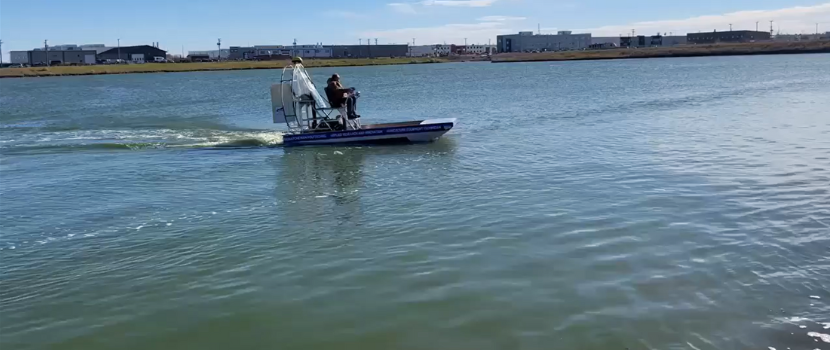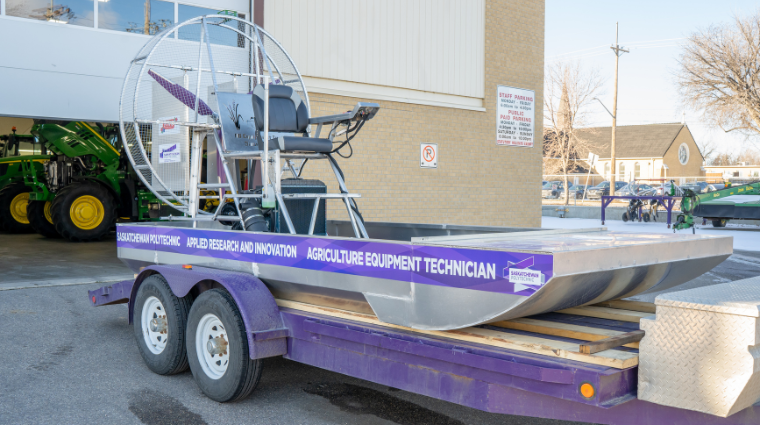
Applied research partnership in the north pairs technology solutions with traditional harvesting practices to create working harvester prototype
Chris Thomson, program head for Saskatchewan Polytechnic’s Agricultural Equipment Technician program, has a knack for fixing machinery and he’s always liked a challenge. He most often works with combines, tractors and farm equipment, teaching students to fix and maintain the equipment used in cereal crop production. Working as a researcher with Sask Polytech’s Sustainability-Led Integrated Centres of Excellence (SLICE), Thomson has more recently branched out to a new crop—wild rice—and the much smaller scale equipment used to harvest it.
The Ag Equipment program head and researcher is leading a collaborative project with multi-year funding support from PrairiesCan’s Community Economic Development and Diversification (CEDD) program. “We are working in partnership with NWC Wild Rice Company and two other educational partners on a multi-faceted project to help with both the equipment used in wild rice harvesting and in training needed to maintain the specialized equipment,” explains Thomson.
NWC Wild Rice Company, an Indigenous-owned northern enterprise, approached Sask Polytech seeking a solution to a common problem faced by harvesters. Wild rice harvester boats are typically small airboats with motors that can maneuver in the tall the grass-like wild rice fields growing along northern lake shores. Current harvester boat propulsion systems use components made for the recreational industry. These regularly fail, quickly become obsolete and are extremely expensive. Thomson’s goal is to design and build a new, modular boat with a more economical and easily repairable propulsion system.
“Thankfully, Sask Polytech has a really wide range of expertise that we have been able to draw from to come up with solutions,” says Thomson. Quintin Dudragne, lead design-tech/fabricator for the project, happens to have as a hobby designing operational models for teaching within 3D modeling programs. The two completed testing on a working prototype for a new boat hull design and propulsion system. Explains Thomson, “We’ve modified the design of a typical boat hull to make it wider so that it can support the larger industrial design engine we’ve been working with. These boats will be loaded with 400 pounds of wild rice and will need to be able to move and steer correctly. Our recent tests proved that the propulsion system works at the required speeds and that’s exciting.”
Thomson and Dudragne recently tested the boat on a small body of water at the edge of Saskatoon’s city limit thanks to the Saskatoon Water Ski Club who supported the team with access to their boat launch. “It functions surprisingly well, speed wise,” says Dudragne. “We’ve made a few little adjustments, trying different belts, pulleys and prop pitch and over a series of tests we got to the point that we’re happy with it and we know that it handles properly.”
“We tried to simulate a harvesting environment,” says Thomson, but ultimately that will require taking the boat up north where wild rice grows. We’ll need to work closely with our NWC partners in the next phases or our applied research project. Our prototype to date has been successful.”
Says Dudrangne, “We couldn’t have done this without the help of quite a few people in different programs. Paul Claypool, a fabrication/welding instructor, helped very early on with bending material that needed to be shaped before assembly. Throughout the fabrication process he has helped us cut and bend a few more metal components. He also had a student weld stainless steel together for the exhaust. And we’ve consulted with instructors in sheet metal for advice on bending aluminum sheets for the boat’s steering components.”
Dudragne lists others at Sask Polytech who have been instrumental in getting the project to this point: “Curtis Morgan, a machinist instructor and one of his students helped make some small metal components on a metal lathe. These were small but significant items that needed to be precise. We also turned to Joey Lorer, a research associate with the Research, Additive Manufacturing and Prototyping (RAMP) lab to help design and simulate the operation of a belt-tensioning mechanism used on the boat’s drive system. We worked together to have the parts water jetted out of metal for assembly.”
Having 3D modeling as a hobby made Dudragne a natural fit this project. “My particular interest in this area helped in creating the 3D model of our ideas. Chris came up with the main concept about how the boat will work and where everything will be located,” he explains, “and I was able to shape it into a computer visual. The whole project has been a group effort. There have been multiple instructors within the Agricultural Equipment Technician program who have helped periodically with the construction of the boat and also the learning material for the maintenance program.”
Training is part of the overall project. Sask Polytech has committed $100,000 towards developing training and maintenance micro-credentials that will be delivered by Dumont Technical Institute, a partner institution that has also committed $100,000 toward delivering the training.
“Designing a better, more sustainable boat is important,” says Thomson, “but sharing knowledge on how to service and maintain the boats once they are in use will be an equally important benefit to the northern communities where Indigenous harvesters gather this traditional crop. NWC’s harvesters will have the opportunity to become self-sufficient operators. In the north, that’s critical.”
SLICE director Dr. Robin Smith agrees, “Sustainability is at the heart of this project. This collaborative applied research will result in new equipment and capability that will bolster an important northern industry.”
Thomson and his team are heading to Beauval to meet with NWC Wild Rice Company and other partners on the project to show progress on the boat and promote the training materials being developed. “We’re looking forward to demonstrating the value that this collaborative project will bring to the people who work with wild rice in Saskatchewan’s north,” he says.
Thomson and Dudragne both note that there is much work yet to be done. “PrairiesCan funding will support our project over three years,” says Thomson, “and we’ll need that time to continue our applied research.” In-house collaborations will continue, with Innovative Manufacturing program instructor Graham Drysdale coming on board to help with the design of the boat’s hull. Dudragne maps out the phases of work he and the team hope to accomplish over the winter, including fabrication of a basket header in the boat’s hull for collecting the rice. “We’ll have to wait until next fall to test that up north,” he says.
There are further project details to be worked out. Thomson hints that there may be possibilities for building fabrication of the boats or parts of them into various programs at Sask Polytech. “That’s still to be determined, says Thomson, “but there’s potential for making this wild rice harvester project a formal part of the learning process for students in a few of our programs.”

For more information, visit saskpolytech.ca/appliedresearch.
Saskatchewan Polytechnic is signatory to the SDG Accord. Sustainable Development Goal alignment is one of the ways Sask Polytech is leading the rise of polytechnic education.



